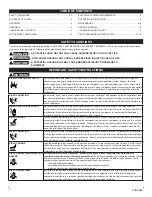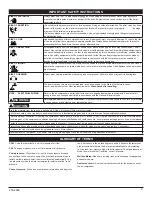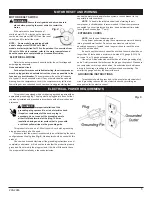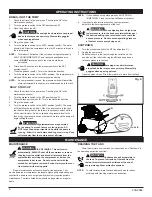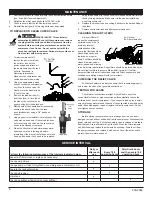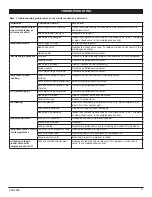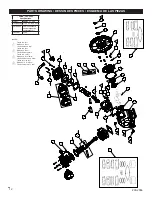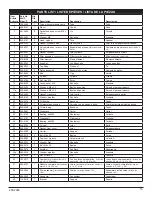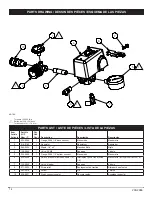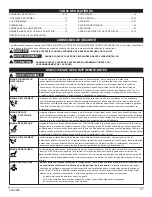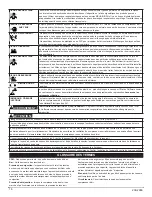
3
200-2966
RISK OF EYE INJURY.
Always wear ANSI Z87.1 approved safety goggles when using an air compressor. Never point any nozzle
or sprayer toward a person, animal or any part of the body. Equipment can cause serious injury if the spray
penetrates the skin.
RISK OF BURSTING.
•Do not adjust the pressure relief valve for any reason. Doing so voids all warranties. The relief valve has been
pre-set at the factory for the maximum pressure of this unit. Personal injury and /or property
damage
may result if the relief valve is tampered with.
•Do not use plastic or pvc pipe for compressed air. Use only galvanized steel pipe and fittings for compressed
air distribution lines.
RISK OF FIRE.
Unattended operation of this compressor could result in personal injury or property damage. To reduce the risk
of fire, do not allow the compressor to operate unattended. Always disconnect electrical power by turning the
pressure switch to off and drain the tank daily or after each use.
RISK TO BREATHING.
Air obtained directly from the compressor should never be used to supply air for human consumption. The air
stream may contain carbon monoxide, toxic vapors, or solid particles from tank. Breathing these contaminant’s
can cause serious injury or death. In order to use air produced by this compressor for breathing, suitable filters
and in-line safety equipment must be properly installed. In-line filters and safety equipment must be properly
installed. In-line filters and safety equipment used in conjunction with the compressor must be capable of
treating air to all applicable local and federal codes prior to human consumption.
RISK OF INJURY.
Always operate the compressor in a stable secure position to prevend accidental movement of the unit. Never
operate the compressor on a table, workbench, roof or other elevated position. Use additional air hose to reach
high locations.
RISK TO HEARING.
Always wear hearing protection when using an air compressor. Failure to do so may result in hearing loss.
The power cord on this product contains lead, a chemical known to the State of California to cause
cancer, and birth defects or other reproductive harm.
Wash hands after handling.
NOTE: ELECTRICAL WIRING.
Refer to the air compressor’s serial label for the unit’s voltage and amperage requirements. Ensure that all
wiring is done by a licensed electrician, in accordance with the National Electrical code.
WARNING:
CALIFORNIA PROPOSITION 65 WARNING:
This product contains chemicals known to the State of California
to cause cancer, birth defects and/or reproductive harm.
CAUTION:
Drain the moisture from the tank on a daily basis. A clean, dry tank will help prevent corrosion.
Pull the tank safety valve ring daily to ensure that the valve is functioning properly, and to clear the valve of any possible obstructions.
To provide proper ventilation for cooling, the compressor must be kept a minimum of 12 inches (31 cm) from the nearest wall, in a well–ventilated area.
Restricting any of the compressor ventilation openings will cause overheating and could cause fire, never place objects against or on top of compressor.
Fasten the compressor down securely if transporting is necessary. Pressure must be released from the tank before transporting.
Protect the air hose and electric cord from damage and puncture. Inspect them weekly for weak or worn spots, and replace if necessary.
To reduce the risk of electric shock, do not expose to rain. Store indoors.
Never operate the compressor if the power cord or plug are damaged. Have the unit serviced at a qualified service center.
CFM:
Cubic feet per minute; a unit of measure of air flow.
PSI:
Pounds per square inch; a unit of measure of air pressure.
Cut-in pressure:
While the motor is off, air tank pressure drops as
you continue to use your accessory. When the tank pressure drops to
factory set low pressure point, the motor will restart automatically. The
low pressure at which the motor automatically restarts is called “cut-in”
pressure.
Cut-out pressure:
When an air compressor is turned on and begins to
run, air pressure in the air tank begins to build. It builds to the factory set
high pressure point before the motor automatically shuts off, protecting
your air tank from pressure higher than its capacity. The high pressure at
which the motor shuts off is called “cut-out” pressure.
Well-ventilated:
Means of providing fresh air in exchange for dangerous
exhaust or vapors.
Dedicated circuit:
An electrical circuit reserved for the exclusive use of
the air compressor.
GLOSSARY OF TERMS
IMPORTANT SAFETY INSTRUCTIONS


